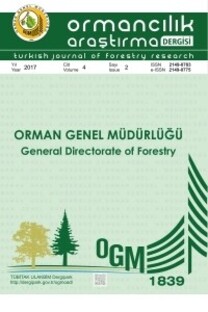İklim Değişikliği Strateji ve Eylem Planlarında Havza Yaklaşımı ve Doğa Temelli Çözümler
İklim Değişikliği, Doğa Temelli Çözümler, Havza Yaklaşımı
Watershed Approach and Nature-Based Solutions in Climate Change Strategies and Action Plans
Climate change, Nature-based solutions, Watershed approach,
___
- Alexander, Serena E., 2020. Harnessing the opportunities and understanding the limits of state level climate action plans in the United States. 0264-2751 2020 Elsevier Ltd. https://doi.org/10.1016/j.cities.2020.102622. Cities 99 (2020) 102622. ScienceDirect 2020.
- Araos, M., Berrang-Ford, L., Ford, J.D., Austin, S.E., Biesbroek, R., Lesnikowski, A., 2016. Climate change adaptation planning in large cities: a systematic global assessment. Environ. Sci. Pol. 66, 375–382. https://doi.org/10.1016/j.envsci.2016.06.009.
- Baker, I., Peterson, A., Brown, G., & McAlpine, C. (2012). Local government response to the impacts of climate change: An evaluation of local climate adaptation plans. Landscape and Urban Planning, 107(2), 127–136. https://doi.org/10.1016/j. landurbplan.2012.05.009.
- Bertoldi, P., Kona, A., Rivas, S., & Dallemand, J. F. (2018). Towards a global comprehensive and transparent framework for cities and local governments enabling an effective contribution to the Paris climate agreement. Current opinion in environmental sustainability, 30, 67-74.
- Carmin J, Nadkarni N, Rhie C. Progress and challenges in urban climate adaptation planning. Boston, MA. 2012.
- Cohen-Shacham, E., Andrade, A., Dalton, J., Dudley, N., Jones, M., Kumar, C., ... & Walters, G. (2019). Core principles for successfully implementing and upscaling Nature-based Solutions. Environmental Science & Policy, 98, 20-29.
- Forman, R. T., & Wu, J. (2016). Where to put the next billion people. Nature News, 537(7622), 608
- Grafakos S, Trigg K, Landauer M, Chelleri L, Dhakal S. Analytical framework to evaluate the level of integration of climate adaptation and mitigation in cities. ClimChange 2019:1–20. https://doi.org/10.1007/s10584-019-02394-w.
- Gunfaus, M. T., & Waisman, H. (2021). Assessing the adequacy of the global response to the Paris Agreement: Toward a full appraisal of climate ambition and action. Earth System Governance, 100102.
- IPCC, 2014: Climate Change 2014: Synthesis Report. Contribution of Working Groups I, II and III to the Fifth Assessment Report of the Intergovernmental Panel on Climate Change [Core Writing Team, R.K. Pachauri and L.A. Meyer (eds.)]. IPCC, Geneva, Switzerland, 151 pp..
- Morgan, J. A. (2019). Rising atmospheric CO2 and global climate change: responses and management implications for grazing lands. In Grasslands: Developments opportunities perspectives (pp. 235-260). CRC Press.
- Pietrapertosa, F., Salvia, M., Hurtado, S. D. G., d'Alonzo, V., Church, J. M., Geneletti, D., ... & Reckien, D. (2019). Urban climate change mitigation and adaptation planning: are Italian cities ready?. Cities, 91, 93-105.
- Reckien, D., Salvia, M., Heidrich, O., Church, J.M., Pietrapertosa, F., De Gregorio-Hurtado.,...& Dawson, R., 2018. How are cities planning to respond to climate change? Assessment of local climate plans from 885 cities in the EU-28. J. Clean. Prod. 191, 207–219. https://doi.org/10.1016/j.jclepro.2018.03.220.
- Reckien, D., Flacke, J., Dawson, R.J., Heidrich, O., Olazabal, M., Foley, A., Hamann, J.J.P., Orru, H., Salvia, M., De Gregorio Hurtado, S., Geneletti, D., Pietrapertosa, F., 2014. Climate change response in Europe: What's the reality? Analysis of adaptation and mitigation plans from 200 urban areas in 11 countries. Climatic Change 122, 331-340. https://doi.org/10.1007/s10584-013-0989-8.
- Salvia, M., Reckien, D., Pietrapertosa, F., Eckersley, P., Spyridaki, N. A., Krook-Riekkola, A., ... & Heidrich, O. (2021). Will climate mitigation ambitions lead to carbon neutrality? An analysis of the local-level plans of 327 cities in the EU. Renewable and Sustainable Energy Reviews, 135, 110253.
- Stults, M., & Woodruff, S. C. (2017). Looking under the hood of local adaptation plans: shedding light on the actions prioritized to build local resilience to climate change. Mitigation and Adaptation Strategies for Global Change, 22(8), 1249-1279.
- Sunde, M. G., He, H. S., Hubbart, J. A., & Urban, M. A. (2018). An integrated modeling approach for estimating hydrologic responses to future urbanization and climate changes in a mixed-use midwestern watershed. Journal of environmental management, 220, 149-162.
- Thompson, I., Mackey, B., McNulty, S., Mosseler, A. (2009). Forest Resilience, Biodiversity, and Climate Change. A synthesis of the biodiversity/resilience/stability relationship in forest ecosystems. Secretariat of the Convention on Biological Diversity, Montreal. Technical Series no. 43, 67 pages.
- Xu, L., Wang, X., Liu, J., He, Y., Tang, J., Nguyen, M., Cui, S., 2019. Identifying the trade-offs between climate change mitigation and adaptation in urban land use planning: an empirical study in a coastal city. Environ. Int. 133, 105162.
- UN (2015). Resolution adopted by the general assembly on 25 September 2015. Transforming our world: the 2030 agenda for sustainable development. New York: UN: n.d.
- WAH, 2014. Watershed Approach Handbook. Improving Outcomes and Increasing Benefits Associated with Wetland and Stream Restoration and Protection Projects.
- Wang, J., Gao, Y., & Wang, S. (2018). Assessing the response of runoff to climate change and human activities for a typical basin in the Northern Taihang Mountain, China. Journal of Earth System Science, 127(3), 1-15.
- Woodruff SC, Stults M. Numerous strategies but limited implementation guidance in US local adaptation plans. Nat Clim Change 2016;6:796–802. https://doi.org/10. 1038/nclimate3012.
- Woodruff SC. City membership in climate change adaptation networks. Environ Sci Policy 2018;84:60–8. https://doi.org/10.1016/j.envsci.2018.03.002.
- Zölch, T., Maderspacher, J., Wamsler, C., & Pauleit, S. (2016). Using green infrastructure for urban climate-proofing: An evaluation of heat mitigation measures at the micro-scale. Urban Forestry & Urban Greening, 20, 305-316.
- ISSN: 2149-0783
- Yayın Aralığı: 2
- Başlangıç: 2014
- Yayıncı: -
Geçmişten günümüze Türkiye’deki endüstriyel ağaçlandırma çalışmalarının değerlendirilmesi
İklim Değişikliği Strateji ve Eylem Planlarında Havza Yaklaşımı ve Doğa Temelli Çözümler
Niyazi ÖZÇANKAYA, Mustafa BATUR, Özgür KİRACIOĞLU
Yetiştirme sıklığının Toros sediri fidanlarının dikim başarısına etkisi
Şükrü Teoman GÜNER, Dilek GÜNER, Uğur ŞAHİN
Gövde analizi çalışmalarında yeni ve kombine bir yöntem
Abbas ŞAHİN, Gafura Aylak ÖZDEMİR, Emrah ÖZDEMİR
Karadağ’ın (Bursa-Balıkesir) bitki toplulukları
Nihal ÖZEL, Hafize Handan ÖNER, Gıyasettin AKBİN, Nuran ALTUN, Kürşad ÖZKAN
Akdağ kütlesinin bazı toprak özelliklerinin model tabanlı dağılım haritaları
Nejat CELİK, KÜRŞAD ÖZKAN, AHMET MERT, Mehmet TÜRKKAN
Yarı kurak ve tuzlu/jipsli alanlarda farklı arazi hazırlığı yöntemlerinin fidan gelişimine etkileri
Farklı ağaç türlerinde çeşitli tomruk hacim formüllerinin karşılaştırılması
